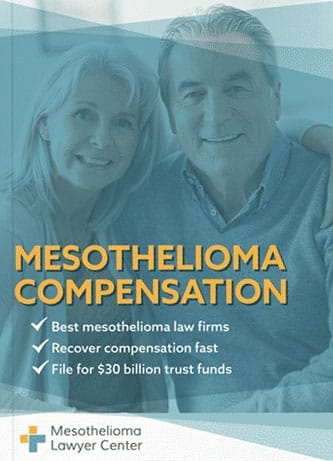Factory workers faced high risks of asbestos exposure until the 1980s, when widespread use of asbestos stopped. Many factories used asbestos in products, machinery, equipment, and building materials. Mesothelioma lawsuits filed by former factory workers are still ongoing today.
If you or a loved one were diagnosed with mesothelioma, asbestosis, or asbestos-related cancer, you might be entitled to substantial compensation. Fill out our form to get a free Financial Compensation Packet. You’ll learn about the experienced mesothelioma lawyers in your area, how to get paid in 90 days, how to file a claim for the asbestos trust funds, and more.


FREE Financial Compensation Packet
- Info on law firms that will recover your HIGHEST COMPENSATION
- Learn how to get paid in 90 days
- File for your share of $30 billion in trust funds
How Were Factory Workers and Industrial Workers Exposed to Asbestos?
Asbestos was used for decades in many industries due to its ability to insulate, protect against heat and fire, and strengthen materials. Industrial factories used asbestos more than many other workplaces.
Workers in these settings may have handled asbestos or products with asbestos directly. This kind of work caused asbestos materials to release fibers that became part of the dust in the air. Whether they handled asbestos or not, workers in the area risked exposure by inhaling the fibers in the air.
Some factories used raw asbestos fibers to make asbestos products. Others used asbestos materials to manufacture other products. Nearly all factories, regardless of what they made, had asbestos in machinery, equipment, and the building itself.
Even in factories that did not make asbestos products, workers risked exposure through fibers released during work and maintenance on machinery and other equipment.
What Materials in Factories Contained Asbestos?
Factories that made asbestos products used raw asbestos fibers. Workers who moved and used these fibers to mix them into other materials or products had very high risks of exposure. Any other workers in the area risked exposure as well.
These types of factories made numerous products with asbestos, including:
- Insulation
- Drywall
- Other construction products
- Asbestos textiles
- Asbestos paper
Asbestos in Machinery and Equipment
All types of factories used equipment and machinery that likely contained asbestos. Asbestos was used to insulate machinery and equipment, for instance, around boilers, furnaces, and steam pipes.
Asbestos was also used to prevent overheating from friction in many components, including pumps, bearings, lathes, and conveyor belts. Parts with asbestos included valves, gaskets, seals, packing, and coatings.
Daily use caused these materials to deteriorate over time, which could lead to exposure to asbestos fibers. Any repairs or maintenance work on equipment could also cause exposure.
Asbestos in Building Components
The factory buildings themselves contained asbestos in many of their components. Most construction materials at one time contained asbestos, from insulation to flooring tiles, adhesives, and roofing. These materials could cause exposure if they deteriorated or were damaged during repair and maintenance work.
Industrial Jobs at Risk for Asbestos Exposure
Factory workers with the highest risks of exposure worked in facilities that handled and used raw asbestos to make products. Manipulating raw asbestos released harmful fibers into the air. Those workers who handled asbestos directly had the highest risks.
Mechanics and maintenance employees who worked in factories faced the highest risk of excessive asbestos exposure.
The workers were required to maintain and repair malfunctioning asbestos-containing machines, which required direct contact with airborne asbestos fibers.
Once the machines were ready for use, factory machinists were at risk of asbestos exposure as soon as they started the equipment.
All workers in factories with asbestos faced some risks of exposure. When asbestos fibers entered the air as dust, anyone in the area could inhale them.
Studies on Factory Workers and Asbestos Exposure
Many studies over the years have proven that factory and industrial workers have faced high rates of asbestos exosure that put them at risk for asbestos illnesses, like mesothelioma.
- A study published by the National Institutes of Health (NIH) described research on asbestos exposure at a factory that manufactured drying machines after 250 former employees passed away. Dust samples and samples from the factory’s drying machines were analyzed. The results found significant amounts of asbestos. Of the 250 former workers who passed away, 234 were found to have either mesothelioma or lung cancer.
- Another study investigated deaths in machine operators in factories and workers who handled industrial insulation. More than 650 workers out of 7,000 died from peritoneal cancer, a type of mesothelioma that affects the abdomen.
- A 2015 study conducted in Belgium looked at deaths related to asbestos in workers between 2001 and 2009. The researchers found that workers in metal factories were 87% more likely to have died of mesothelioma when compared to other workers.
- A study from 2010 involved workers at a Raybestos factory in Connecticut. They manufactured asbestos friction products. A previous study had claimed that nobody from the factory died from asbestos exposure. The more current study found at least seven deaths related to asbestos among the workers.
Are Factory Workers Still at Risk of Asbestos Exposure?
Factory workers today have much less risk of asbestos exposure. The risk is not zero because asbestos lingers in older factories. Deteriorating materials can still cause exposure. Maintenance and repair work can also cause exposure.
Most importantly, people who worked in factories before the 1980s are at a heightened risk of developing asbestos illnesses such as malignant mesothelioma, asbestosis, and asbestos-related lung cancer.
Factory Workers and Mesothelioma Lawsuits
The high amount of asbestos exposure and related diseases that factory workers faced resulted in mesothelioma and asbestos-related lawsuits against the manufacturers that once supplied asbestos to companies.
In 2008, the family of Mark Buttitta, a former factory worker from Hackensack, New Jersey, filed an asbestos lawsuit in Bergen County after Buttitta passed away from mesothelioma.
Buttitta worked at General Motors (GM) in the parts warehouse in both Bloomfield and Englewood, which led to asbestos exposure and premature death at the age of 50.
According to the family attorney, Buttitta’s case was just one of the many cases in which factory workers in New Jersey were unaware of the dangers they were facing at work.
“In Bloomfield, Englewood, and all across New Jersey, men and women who wouldn’t know a brake shoe from a horseshoe can be struck down by this horrible disease decades later from simply living with someone who dealt with asbestos in his daily occupation. In Mark Buttitta’s case we were able to get justice for him and his young family.”
Buttitta’s family won over $30 million.
Manufacturers That Used Asbestos in Factories
Many manufacturers supplied factories with asbestos or made asbestos products, including:
- Johns Manville
- Honeywell
- Turner & Newell
- BF Goodrich
- Celotex
- Dana Corporation
- Raybestos
- Porter Hayden Co.
- John Crane Co.
What to Do if You Were Exposed to Asbestos in a Factory
If you worked in a factory during peak years of asbestos use, talk to your doctor about the risks and any medical screenings you need. Not everyone exposed to asbestos gets sick, but for those who do, an early diagnosis produces a better outcome.
If you get a diagnosis of mesothelioma or another asbestos illness, talk to an experienced mesothelioma lawyer. They can review your work history, identify companies responsible for your exposure, and help you take steps to seek compensation.
Additional Help and Resources for Factory Workers
If you’ve been injured by mesothelioma, asbestosis, or asbestos-related cancer, keep in mind that there is a good chance that you’ll qualify for considerable compensation. Don’t forget to fill out our form to get our free Financial Compensation Packet, filled with information on the experienced asbestos and mesothelioma attorneys in your area.

Paul Danziger
Reviewer and EditorPaul Danziger grew up in Houston, Texas and earned a law degree from Northwestern University School of Law in Chicago. For over 25 years years he has focused on representing mesothelioma cancer victims and others hurt by asbestos exposure. Paul and his law firm have represented thousands of people diagnosed with mesothelioma, asbestosis, and lung cancer, recovering significant compensation for injured clients. Every client is extremely important to Paul and he will take every call from clients who want to speak with him. Paul and his law firm handle mesothelioma cases throughout the United States.
References
- Berry, G., Newhouse, M., and Wagner, J. (2000, November). Mortality from All Cancers of Asbesetos Factory Workers in East London 1933-80. Occup. Environ. Med. 57(11), 782-5.
Retrieved from: http://www.ncbi.nlm.nih.gov/pmc/articles/PMC1739888/ - Finkelstein, M.M. (1989, July 15). Mortality Rates Among Employees Potentially Exposed to Chrysotile Asbestos at Two Automotive Parts Factories. CMAJ. 141(2), 125-30.
Retrieved from: http://www.ncbi.nlm.nih.gov/pmc/articles/PMC1269336/?page=4 - Fedi, A., Blagini, B., Melosi, A., Marzuoli, E., Ancillotti, M., Gorini, G., Constantini, A.S., Silvestri, S., and Innocenti, A. (2005). Assessment of Asbestos Exposure, Mortality Study, and Health Intervention in Workers Formerly Exposed to Asbestos in a Small Facory Making Drying Machines for Textile Finishing and the Paper Mill Industry in Pistoia, Italy. Med Lav. 96(3), 243-9.
Retrieved from: http://www.ncbi.nlm.nih.gov/pubmed/16273843 - Superior Court of New Jersey, Appellate Division. (2011, July 28). Buttitta v. Allied-Signal, Inc.
Retrieved from: https://www.leagle.com/decision/innjco20110728265 - Cocco, P. and Dosemeci, M. (1999, January). Peritoneal Cancer and Occupational Exposure to Asbestos: Results From the Application of a Job-Exposure Matrix. Am. J. Ind. Med. 35(1), 9-14.
Retrieved from: https://www.ncbi.nlm.nih.gov/pubmed/9884740 - Van den Bourre, L. and Deboosere, P. (2015). Enduring Health Effects of Asbestos use in Belgian Industries: A Record-Linked Cohort Study of Cause-Specific Mortality (2001-2009). BMJ Opendoi: 10.1136/bmjopen-2014-007384.
Retrieved from: https://bmjopen.bmj.com/content/5/6/e007384 - Finkelstein, M.M. and Meisenkothen, C. (2010, June 3). Malignant Mesothelioma Among Employees of a Connecticut Factory that Manufactured Friction Materials Using Chrysotile Asbestos. Ann. Occup. Hyg. 54(6), 692-6.
Retrieved from: https://academic.oup.com/annweh/article/54/6/692/151994
